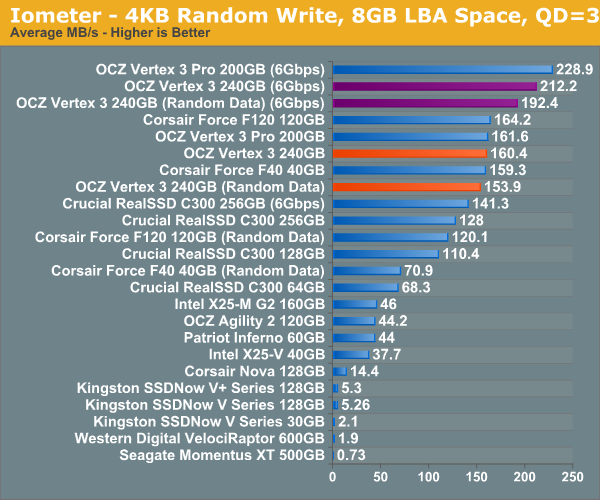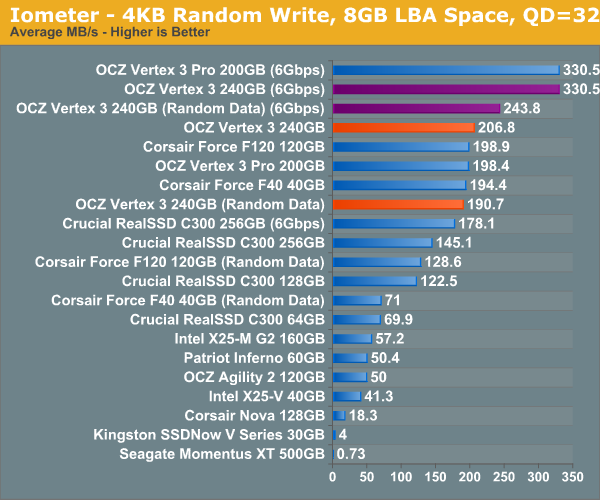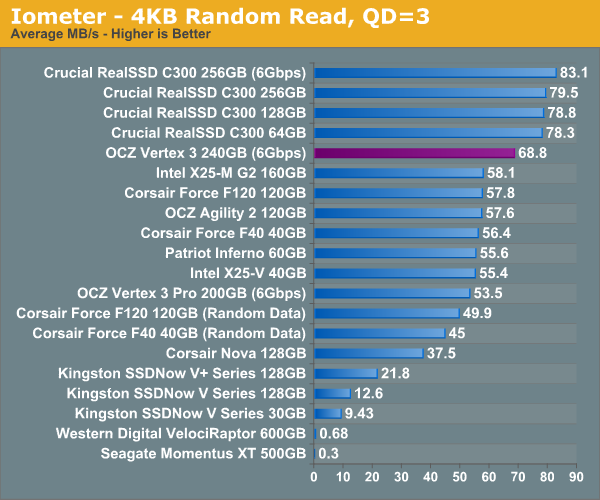OCZ Vertex 3 Preview: Faster and Cheaper than the Vertex 3 Pro
by Anand Lal Shimpi on February 24, 2011 9:02 AM ESTRandom Read/Write Speed
The four corners of SSD performance are as follows: random read, random write, sequential read and sequential write speed. Random accesses are generally small in size, while sequential accesses tend to be larger and thus we have the four Iometer tests we use in all of our reviews.
Our first test writes 4KB in a completely random pattern over an 8GB space of the drive to simulate the sort of random access that you'd see on an OS drive (even this is more stressful than a normal desktop user would see). I perform three concurrent IOs and run the test for 3 minutes. The results reported are in average MB/s over the entire time. We use both standard pseudo randomly generated data for each write as well as fully random data to show you both the maximum and minimum performance offered by SandForce based drives in these tests. The average performance of SF drives will likely be somewhere in between the two values for each drive you see in the graphs. For an understanding of why this matters, read our original SandForce article.

Many of you have asked for random write performance at higher queue depths. What I have below is our 4KB random write test performed at a queue depth of 32 instead of 3. While the vast majority of desktop usage models experience queue depths of 0 - 5, higher depths are possible in heavy I/O (and multi-user) workloads:












85 Comments
View All Comments
ErikO - Wednesday, March 9, 2011 - link
It has been over two years, since I took the plunge for SSD, and on my third one, (Intel SLC), I'm loving it, as McDonalds marketing team would surely love everyone to say.I started with that woeful OCZ SSD, (that created more noise than the Mohammad Cartoons in the world).
They sent me a second one by some way of peace offering (I wrote them from the address of a small tech site I own), but public reviews said they were just as bad. Sold on Ebay with no reserve. (almost got my money back too)
Then a year ago, my wallet allowed for a 160GB X25-M. That was -worlds- better, but still every now and then (once an hour?) my music would skip - and I recognised that as MLC behaviour. This would be the high-latency small-file-size writes then. But as an audiophile, who does actually connect his computer to his hi-fi (via a dedicated sound card of course), this meant noticable breaks in a high output system. Not cool in front of guests.
So a couple of weeks back, I bought the 64GB X25-E. This was everything I had hoped for. This is what I expected SSDs would give us from day one. The size of the disk is painful though, but I digress.
My question is...with all these much higher results out there, am I really going to perceive much of a difference in system-wide performance? Intel seems to be dropping SLC as far as I can see, and based on my experience, I don't think I can / could turn my back on SLC technology again...!
So where is all the talk of the X25-E - of recent? They are for sale everywhere, but the internet seems almost dead to their existance. Too small? Too expensive?
Even if I can be convinced into a Vertex, I will definately have to pay the high admission cost for the pro...I'd happily sacrifice some speed for consistancy of performance.
Gents, let me know what you know?
Thanks.
SeattleGeek - Thursday, March 10, 2011 - link
Will the 128GB model perform the same as the 256GB model that is reviewed?Also, do they have the same number of channels?
sean.crees - Friday, March 11, 2011 - link
Where are the benchmarks for the Vertex 2? I'd really like to see how exactly the new Vertex 3 compares to the drive it's supposed to replace.Dssguy1 - Monday, April 18, 2011 - link
Because we know OCZ is infamous for trickery, I would like to know if you got some kind of "super juiced-up" version of the drive for review.It would make me feel a lot better about dropping $550 (basically because I just did), if I knew that the review SSD you tested, matches what we are getting when we buy the Retail version.
davele - Friday, December 30, 2011 - link
Based on what you describe I wonder if this testing is really a representative snapshot of any common use pattern.ie: Application installs - typically this is a once off activity. Any one machine only installs a finite number of applications. (the exception being a SCOM based virtual desktop where the entire systems is installed each time a user logs on. But that is Enterprise & they are very unlikely to put SSD's in user workstations)
For Enterprise SSD benchmarks please consider profiling a SQL Server system running both normal OLTP app & a Sharepoint app.
The OLTP would give you huge numbers of 4K & 64K random writes, while the logs would give you largely a sequential write. The Sharepoint app is a heavy BLOB store, So this would give you the a random set of large sequential I/O, with much more Read than Write.
The advantage of this is you can backup the database, capture the I/O requests. Then each test is just a restore & replay of the requests. Easy, repeatable & extremely representative of Heavy I/O workload. Especially an enterprise class load.